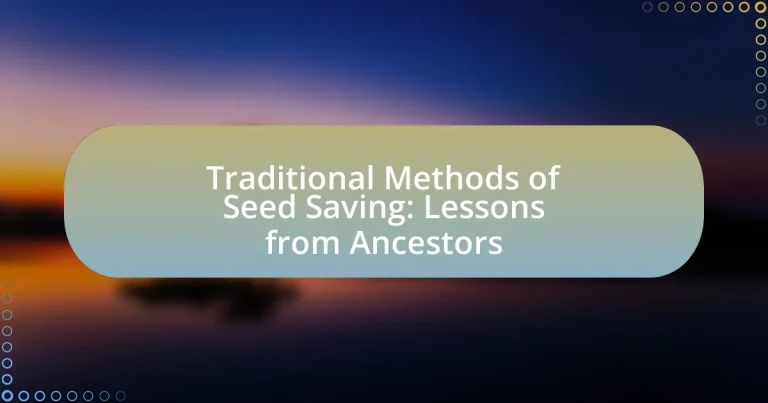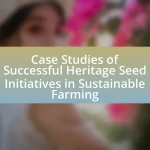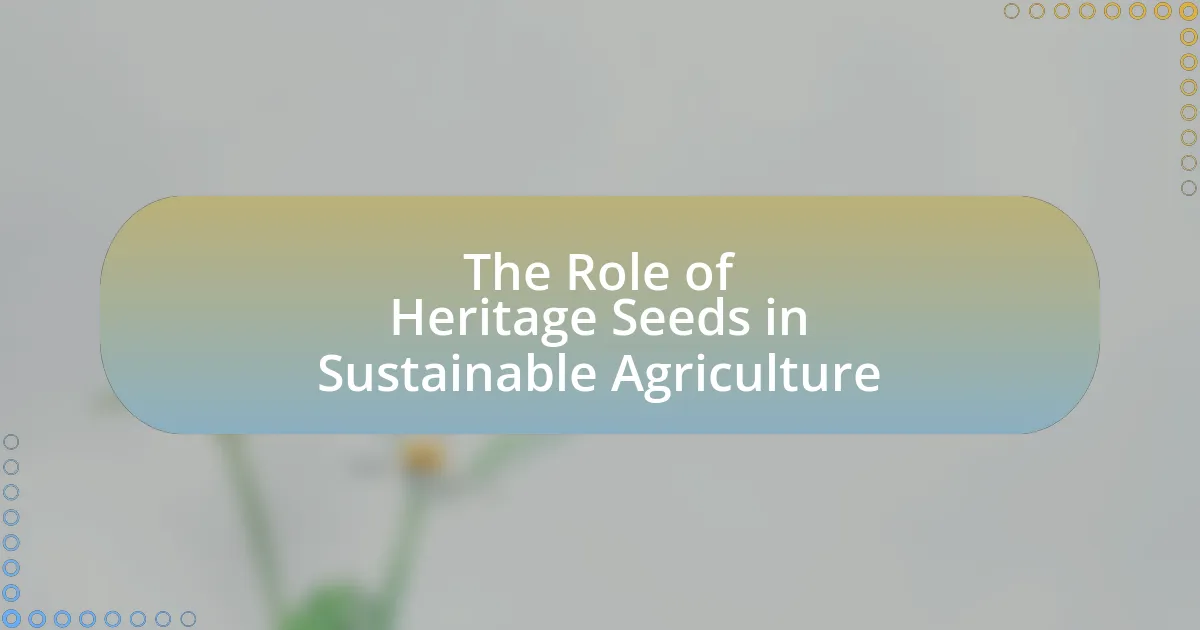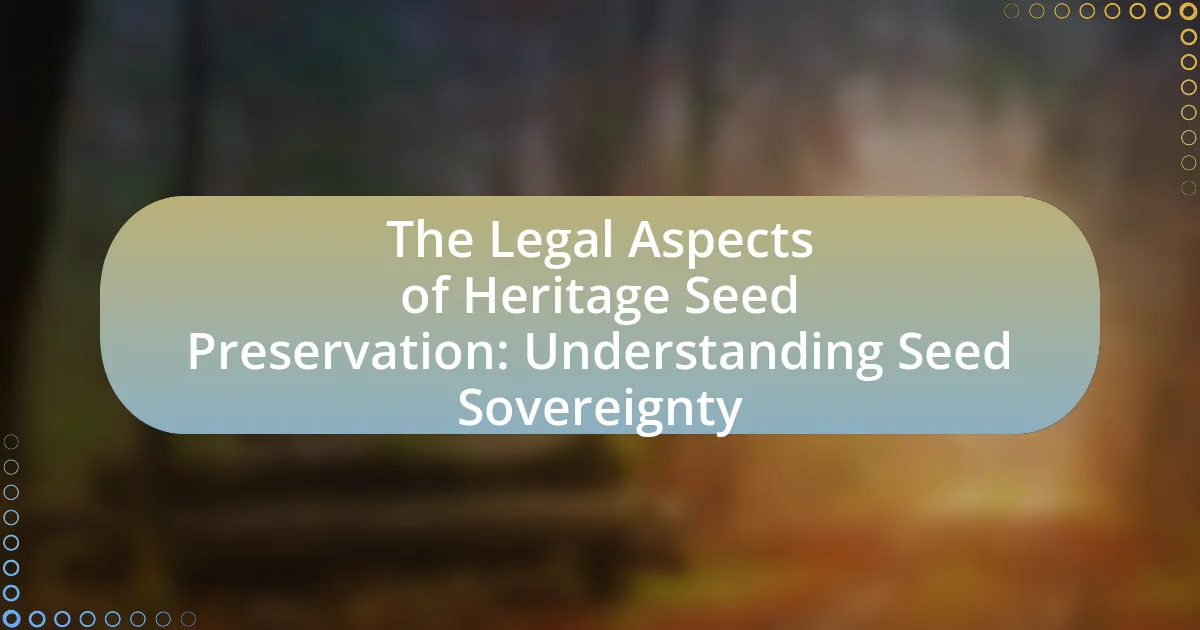Traditional methods of seed saving encompass techniques such as selecting seeds from the healthiest plants, proper drying, and appropriate storage to ensure seed viability. These practices, rooted in historical agricultural knowledge, have evolved over time, integrating modern scientific advancements while maintaining cultural significance. The article explores the historical influences on contemporary seed saving techniques, the impact of cultural differences, and the importance of seed saving for biodiversity and food security. It also addresses the challenges posed by industrial agriculture and offers practical tips for individuals to engage in seed saving at home, emphasizing the need to preserve traditional knowledge for future generations.

What are Traditional Methods of Seed Saving?
Traditional methods of seed saving include techniques such as selecting seeds from the healthiest plants, drying seeds properly, and storing them in cool, dark, and dry environments. These practices have been utilized for centuries by various cultures to ensure the viability and quality of seeds for future planting. For instance, farmers often choose seeds from plants that exhibit desirable traits, such as disease resistance or high yield, thereby promoting the continuation of these traits in subsequent generations. Additionally, proper drying prevents mold and decay, while appropriate storage conditions help maintain seed viability over time. Historical evidence shows that these methods have been passed down through generations, demonstrating their effectiveness in sustaining agricultural practices.
How have traditional methods evolved over time?
Traditional methods of seed saving have evolved significantly over time, transitioning from purely manual techniques to incorporating modern agricultural practices. Initially, seed saving involved farmers selecting and preserving seeds from the best-performing plants within their local environment, a practice rooted in traditional knowledge passed down through generations. As agricultural science advanced, these methods began to integrate improved techniques such as controlled pollination and genetic selection, enhancing crop resilience and yield. For instance, the introduction of hybrid seeds in the mid-20th century revolutionized seed saving by offering higher productivity, although it also shifted the focus from traditional practices to commercial seed production. This evolution reflects a broader trend where traditional knowledge is increasingly complemented by scientific research, leading to more sustainable and efficient agricultural practices.
What historical practices influenced modern seed saving techniques?
Historical practices such as selective breeding, crop rotation, and communal seed sharing have significantly influenced modern seed saving techniques. Selective breeding, practiced by ancient civilizations like the Mesopotamians, involved choosing seeds from the best-performing plants to enhance desirable traits, a method still used today to improve crop yields and resilience. Crop rotation, utilized by the Romans, helped maintain soil fertility and reduce pest populations, informing contemporary practices that promote biodiversity and sustainability in agriculture. Additionally, communal seed sharing, a tradition among indigenous cultures, emphasized the importance of preserving local varieties and genetic diversity, which is now recognized as crucial for food security and adaptation to climate change. These historical practices laid the foundation for the principles and methods employed in modern seed saving.
How do cultural differences shape seed saving methods?
Cultural differences significantly shape seed saving methods by influencing the selection of seeds, preservation techniques, and the knowledge passed down through generations. For instance, in Indigenous cultures, seed saving often involves selecting seeds that are well-adapted to local climates and ecosystems, reflecting a deep understanding of biodiversity and sustainability. In contrast, industrialized societies may prioritize high-yield varieties, which can lead to a loss of traditional knowledge and genetic diversity. Research indicates that traditional seed saving practices, such as those observed in the Andean region, emphasize community involvement and cultural identity, reinforcing the importance of local agricultural heritage. This cultural context not only affects the methods used but also the values associated with seed saving, highlighting the role of cultural identity in agricultural practices.
Why is seed saving important in agriculture?
Seed saving is important in agriculture because it preserves genetic diversity and ensures the availability of resilient crop varieties. By saving seeds from successful plants, farmers can adapt to changing environmental conditions and pests, which is crucial for food security. Historical practices show that traditional seed saving has led to the development of local varieties that are better suited to specific climates and soils, enhancing agricultural sustainability. For instance, studies indicate that diverse seed banks can improve crop yields by up to 20% in adverse conditions, demonstrating the tangible benefits of maintaining genetic diversity through seed saving.
What role does seed saving play in biodiversity conservation?
Seed saving plays a crucial role in biodiversity conservation by preserving genetic diversity within plant species. This practice allows farmers and communities to maintain a wide variety of crops, which is essential for adapting to changing environmental conditions and combating pests and diseases. For instance, the International Plant Genetic Resources Institute reports that seed saving contributes to the conservation of over 1,500 varieties of crops, ensuring that diverse genetic traits are available for future cultivation. By maintaining these diverse seed stocks, communities can enhance resilience against climate change and food insecurity, thereby supporting overall ecosystem health.
How does seed saving contribute to food security?
Seed saving contributes to food security by preserving genetic diversity and ensuring the availability of resilient crop varieties. This practice allows farmers to maintain a stable supply of seeds that are adapted to local conditions, which is crucial for adapting to climate change and pest pressures. According to the Food and Agriculture Organization, traditional seed systems can enhance food security by providing access to a wider range of crops, thus reducing dependency on commercial seed markets and increasing self-sufficiency among communities.
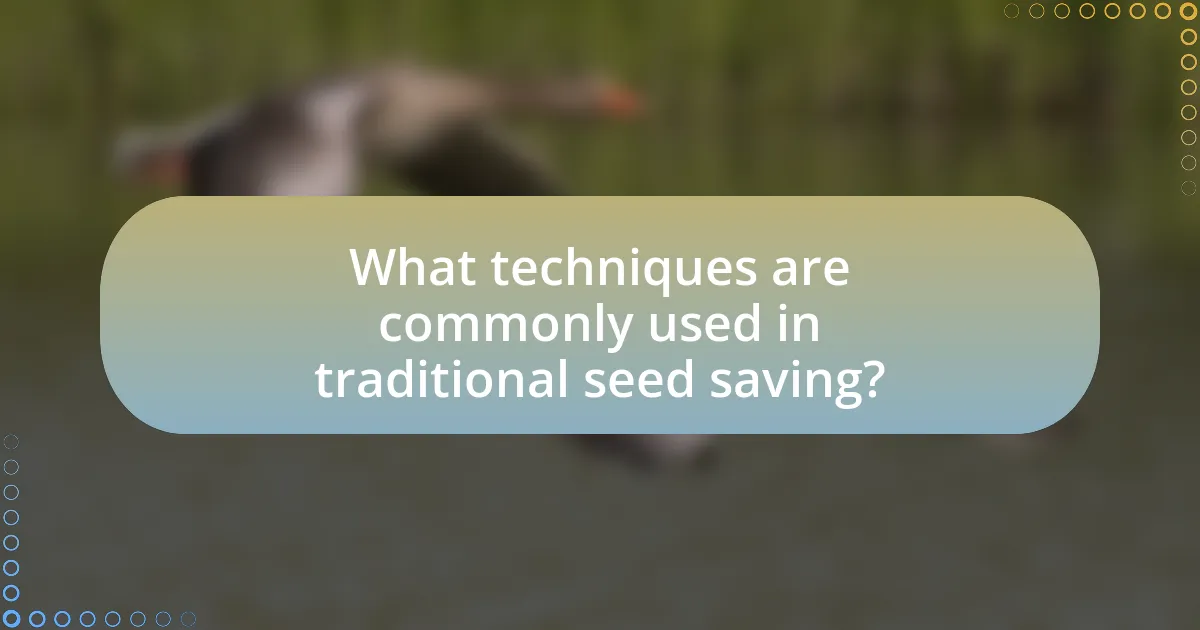
What techniques are commonly used in traditional seed saving?
Common techniques used in traditional seed saving include selection, drying, and storage. Selection involves choosing the best seeds from the healthiest plants to ensure genetic quality and adaptability. Drying is crucial for preventing mold and decay, typically achieved by air-drying seeds in a cool, dark place. Storage methods often involve using breathable containers, such as paper bags or cloth pouches, to maintain seed viability over time. These practices have been passed down through generations, demonstrating their effectiveness in preserving plant diversity and ensuring successful future harvests.
How do farmers select seeds for saving?
Farmers select seeds for saving based on traits such as yield, disease resistance, and adaptability to local conditions. They often choose seeds from the healthiest and most productive plants, ensuring that these characteristics are passed on to future generations. This practice is rooted in traditional methods, where farmers have historically relied on their observations and experiences to identify the best-performing plants in their specific environments. By selecting seeds that exhibit desirable traits, farmers can enhance crop resilience and maintain agricultural biodiversity, which is crucial for sustainable farming practices.
What criteria do farmers use to choose the best seeds?
Farmers choose the best seeds based on criteria such as adaptability to local climate, disease resistance, yield potential, and seed quality. Adaptability ensures that the seeds can thrive in specific environmental conditions, while disease resistance helps minimize crop losses. Yield potential is crucial for maximizing productivity, and seed quality, which includes factors like germination rate and purity, directly impacts the success of planting. These criteria are supported by agricultural studies indicating that selecting seeds with these characteristics leads to improved crop performance and sustainability in farming practices.
How does the selection process vary by crop type?
The selection process varies by crop type primarily due to differences in growth habits, reproductive strategies, and environmental adaptations. For instance, self-pollinating crops like wheat and rice require less stringent selection criteria compared to cross-pollinating crops such as corn and squash, which necessitate careful management of genetic diversity to maintain desirable traits. Additionally, root crops like potatoes focus on tuber quality and disease resistance, while leafy crops like spinach prioritize leaf size and texture. Historical practices show that farmers have tailored their selection methods based on these characteristics, ensuring that the chosen seeds are best suited for local conditions and intended uses.
What methods are used to store saved seeds?
Saved seeds are typically stored using methods that ensure their viability and longevity, such as drying, refrigeration, and using airtight containers. Drying seeds reduces moisture content, which is crucial for preventing mold and decay. Refrigeration further slows down the metabolic processes of seeds, extending their lifespan. Airtight containers, such as glass jars or vacuum-sealed bags, protect seeds from moisture and pests, ensuring they remain viable for future planting. These methods are supported by agricultural practices that emphasize the importance of maintaining seed quality for successful cultivation.
What are the best practices for seed storage to ensure viability?
The best practices for seed storage to ensure viability include maintaining low moisture levels, controlling temperature, and using appropriate containers. Seeds should be dried to a moisture content of around 6-8% to prevent mold and decay, as high moisture can lead to seed deterioration. Storing seeds in a cool, dark place, ideally at temperatures between 32°F and 41°F (0°C to 5°C), helps to prolong their lifespan. Airtight containers, such as glass jars or vacuum-sealed bags, protect seeds from humidity and pests, further enhancing their viability. Research indicates that proper seed storage can significantly extend germination rates, with some seeds remaining viable for decades when stored under optimal conditions.
How do environmental factors affect seed storage methods?
Environmental factors significantly influence seed storage methods by affecting seed viability and longevity. Temperature, humidity, and light exposure are critical elements; for instance, seeds stored in cool, dry, and dark conditions tend to maintain their viability longer than those exposed to high temperatures and humidity. Research indicates that seeds stored at temperatures below 10°C and relative humidity below 50% can remain viable for decades, while higher humidity levels can lead to mold growth and seed deterioration. Therefore, understanding and controlling these environmental factors is essential for effective seed storage and preservation.

What lessons can we learn from our ancestors about seed saving?
Ancestors teach us the importance of selecting seeds from the healthiest and most productive plants for seed saving. This practice, rooted in traditional agriculture, emphasizes the significance of genetic diversity and adaptation to local conditions. For instance, Indigenous farmers in the Americas have historically saved seeds from crops that thrived in their specific environments, ensuring resilience against pests and climate variations. This method not only preserves plant varieties but also enhances food security by maintaining a diverse gene pool, which is crucial for adapting to changing agricultural challenges.
How can traditional knowledge be integrated into modern practices?
Traditional knowledge can be integrated into modern practices by incorporating ancestral techniques and insights into contemporary agricultural methods. For instance, farmers can adopt traditional seed-saving practices that emphasize biodiversity and resilience, which have been proven to enhance crop yields and sustainability. Research indicates that traditional varieties often possess traits such as drought resistance and pest tolerance, which are increasingly valuable in the face of climate change. By blending these time-tested methods with modern technology, such as data analytics for crop management, agricultural systems can become more efficient and sustainable.
What are the benefits of combining traditional and modern seed saving techniques?
Combining traditional and modern seed saving techniques enhances biodiversity and resilience in agriculture. Traditional methods often focus on local adaptation and preservation of heirloom varieties, which contribute to genetic diversity. Modern techniques, such as genetic analysis and controlled breeding, improve disease resistance and yield. By integrating these approaches, farmers can maintain the unique traits of traditional seeds while benefiting from the advancements in agricultural science. This synergy not only supports sustainable farming practices but also helps in adapting to climate change, as diverse seed banks can provide options for varying environmental conditions.
How can we preserve traditional seed saving knowledge for future generations?
To preserve traditional seed saving knowledge for future generations, communities must actively document and share their practices through workshops, educational programs, and digital platforms. Research indicates that intergenerational knowledge transfer is crucial; for instance, a study by the Food and Agriculture Organization highlights that local farmers who engage in seed saving often pass down techniques and varieties through hands-on experiences and storytelling. Additionally, creating seed banks and community gardens can serve as living repositories of traditional practices, ensuring that diverse seed varieties and their associated cultural knowledge are maintained and accessible.
What challenges do we face in maintaining traditional seed saving practices?
Maintaining traditional seed saving practices faces several challenges, including loss of biodiversity, legal restrictions, and changing agricultural practices. Loss of biodiversity occurs as modern agricultural methods favor hybrid and genetically modified seeds over traditional varieties, leading to a decline in the genetic diversity essential for resilient ecosystems. Legal restrictions, such as seed patenting and regulations on seed exchange, hinder farmers’ ability to save and share seeds freely, which is a cornerstone of traditional practices. Additionally, changing agricultural practices, driven by industrialization and commercialization, prioritize high-yield crops and monocultures, further marginalizing traditional seed saving methods. These factors collectively threaten the sustainability and continuity of traditional seed saving practices.
How do industrial agriculture practices threaten traditional methods?
Industrial agriculture practices threaten traditional methods by promoting monoculture and the use of synthetic inputs, which undermine biodiversity and local farming knowledge. Monoculture, the cultivation of a single crop over a wide area, reduces genetic diversity, making crops more susceptible to pests and diseases, as evidenced by the Irish Potato Famine in the 1840s, where reliance on a single potato variety led to widespread crop failure. Additionally, the reliance on chemical fertilizers and pesticides diminishes the traditional practices of organic farming and seed saving, as these methods often prioritize high-yield varieties over heirloom seeds, which are crucial for maintaining local agricultural heritage. This shift not only erodes the cultural practices associated with traditional farming but also threatens food sovereignty by making farmers dependent on commercial seed suppliers.
What strategies can be employed to overcome these challenges?
To overcome the challenges of traditional seed saving, farmers can implement strategies such as diversifying seed varieties, utilizing community seed banks, and adopting integrated pest management practices. Diversifying seed varieties enhances resilience against pests and diseases, as evidenced by studies showing that genetic diversity can reduce crop failure rates. Community seed banks facilitate the sharing and preservation of local seed varieties, which strengthens local agricultural systems and ensures access to adapted seeds. Integrated pest management practices reduce reliance on chemical pesticides, promoting healthier ecosystems and sustainable farming. These strategies collectively address the challenges faced in traditional seed saving by enhancing biodiversity, community collaboration, and sustainable practices.
What practical tips can enhance traditional seed saving efforts?
To enhance traditional seed saving efforts, gardeners should focus on selecting seeds from the healthiest and most productive plants. This practice ensures that the seeds carry desirable traits, such as disease resistance and high yield. Additionally, proper drying and storage techniques are crucial; seeds should be thoroughly dried to prevent mold and stored in a cool, dark, and dry environment to maintain viability. Research indicates that seeds stored under optimal conditions can remain viable for several years, with some varieties lasting over a decade. Furthermore, maintaining detailed records of seed sources and planting conditions can help in selecting the best seeds for future planting, thereby improving overall crop performance.
How can individuals start their own seed saving practices at home?
Individuals can start their own seed saving practices at home by selecting healthy, mature plants from which to collect seeds. This involves allowing the plants to fully mature and dry out before harvesting the seeds, ensuring they are viable for future planting. For example, heirloom varieties of tomatoes or beans are excellent choices, as they produce seeds that will grow true to type in subsequent generations.
To effectively save seeds, individuals should clean and store them in a cool, dry place, using paper envelopes or glass jars to prevent moisture and pests. Research indicates that proper seed storage can maintain viability for several years, with some seeds lasting up to a decade when stored correctly. By following these steps, individuals can successfully engage in seed saving, preserving plant diversity and contributing to sustainable gardening practices.
What resources are available for learning more about traditional seed saving?
Resources for learning about traditional seed saving include books, online courses, and community workshops. Notable books such as “Seed to Seed” by Suzanne Ashworth provide comprehensive guides on seed saving techniques for various plant species. Online platforms like the Seed Savers Exchange offer educational resources and forums for sharing knowledge among enthusiasts. Additionally, local agricultural extension services often conduct workshops that focus on traditional seed saving practices, allowing participants to gain hands-on experience. These resources collectively support the preservation of heirloom varieties and promote sustainable gardening practices.
